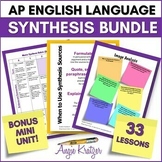Paraphrasing & Summarizing Lesson Plans, Paraphrasing Practice, Summary Writing
- PDF
- Google Apps™

Also included in
- The AP® English Language synthesis question requires an understanding of argumentation, synthesis, and smooth source use. This bundle hits all the skills necessary for success for Question 1 on the AP® Lang exam.Save $15.00 by combining these three complementary products:Synthesis Essay Unit for AP®Price $27.97Original Price $42.97Save $15.00
Description
Do your students need summarizing practice and paraphrasing practice? Students plagiarize often because they don't know how to perform those two processes correctly. If they know how to do it, they'll be more likely to take the time to try during the research process.
This two-lesson, ten-handout resource builds on Marzano's research about the value of using analogies to help students connect with content. Examples and practice exercises are funny, relevant, and teen-oriented.
These two lessons are a 24-page excerpt of The Research Process Step by Step.
These two lessons are aligned with Common Core State Standards and TEKS and are provided in both PDF and Google Slides.
Suggestions for Use
✏️ Get in front of bad research skills by teaching these two lessons BEFORE students take notes.
✏️ Remediate in a small group setting with students who are having trouble with these two processes.
✏️ Use these lesson plans as part of a high school transition summer program.
✏️ Use with any content area! For example, a social studies teacher can use these lessons to prepare students for the AP DBQ or a research project.
✏️ Use these lessons in 1:1 tutoring.
✏️ Use with ELLs to help them understand the difference.
✏️ Use the summarizing materials in reading instruction.
Stellar Reviews
⭐️⭐️⭐️⭐️⭐️I have used this to help me prepare my lessons for my new AP Lang class. It is thorough and I appreciate the amount of work that has gone into this resource. I feel more confident going into my first year as an AP Lang teacher. Michelle H.
⭐️⭐️⭐️⭐️⭐️I used this with a young man headed off to college. The explanations and passages to summarize and paraphrase were great. Thanks! Lisa M.
⭐️⭐️⭐️⭐️⭐️Really helped my junior and high school ELLs understand the difference, thank you! Gary B.
⭐️⭐️⭐️⭐️⭐️These lessons simplify and closely examine a difficult pair of skills. I.T.






